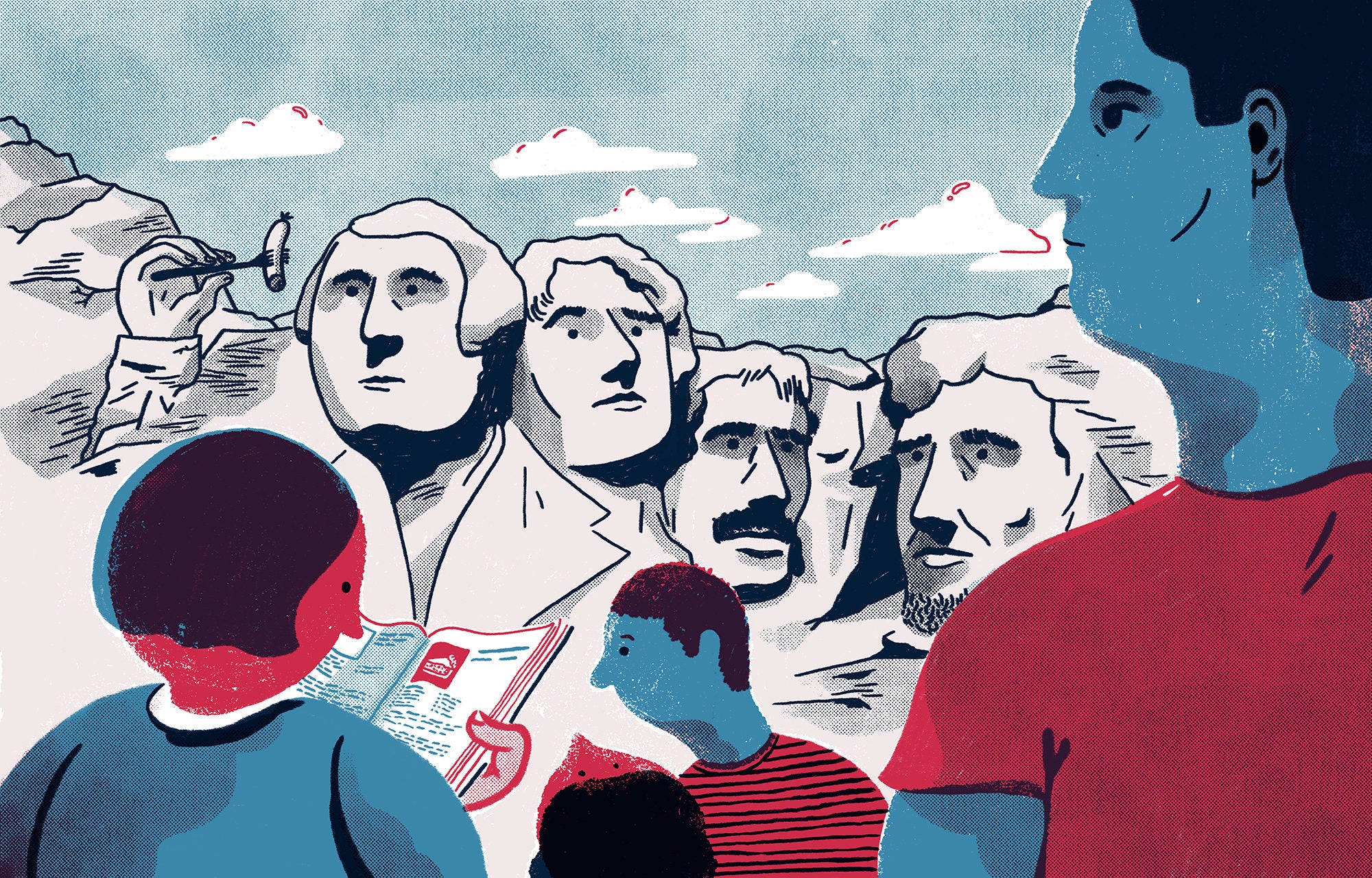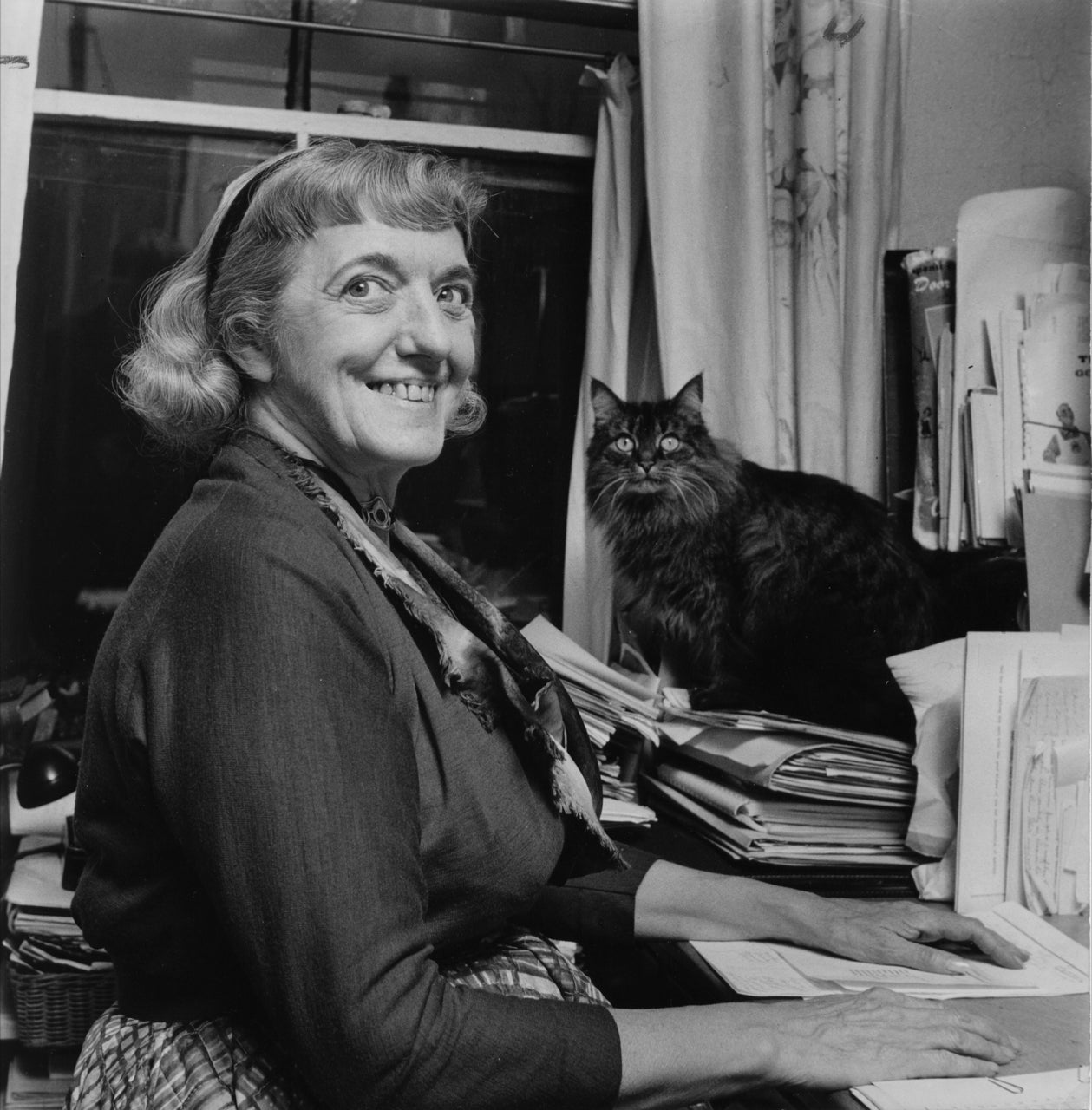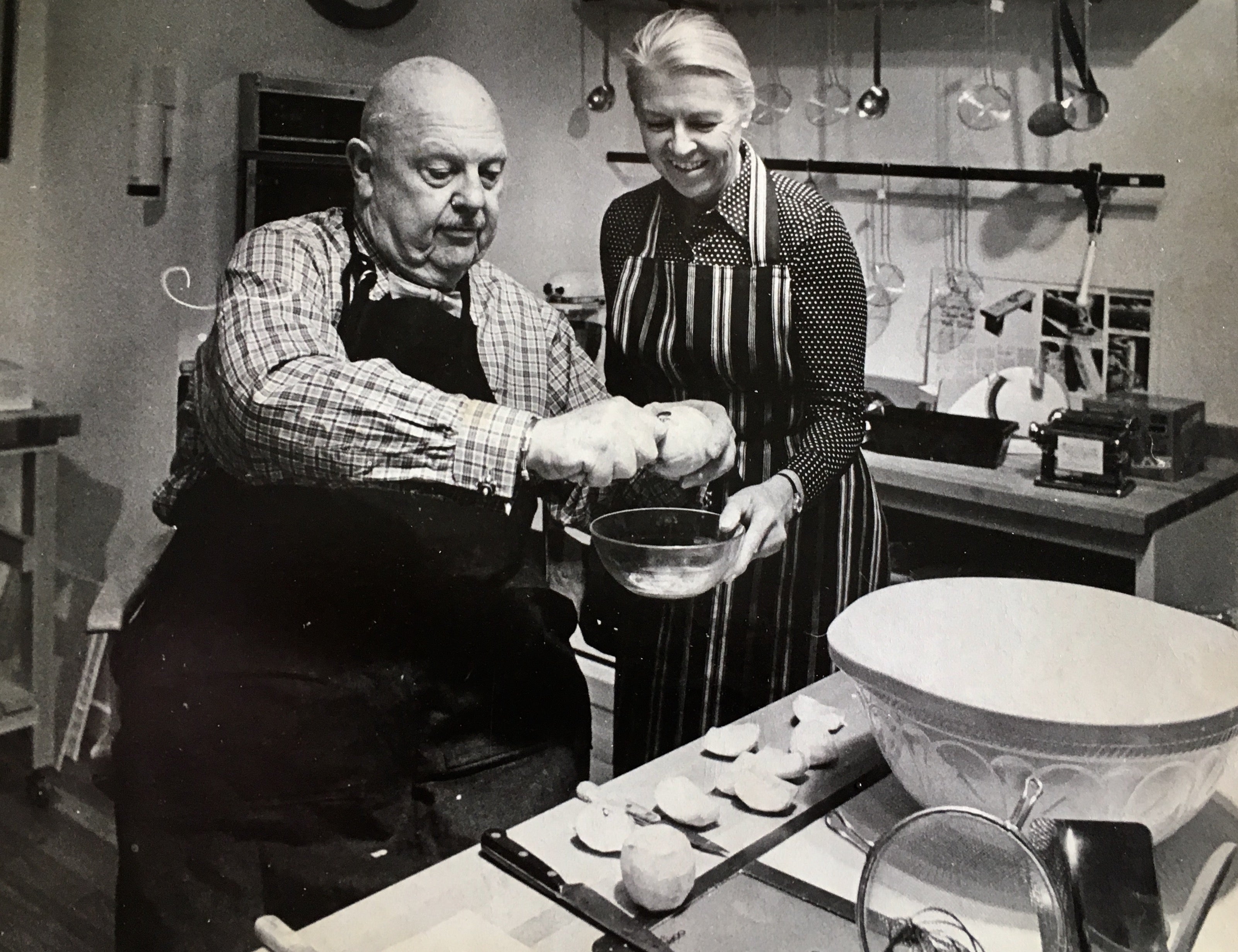
For almost as long as America has existed, cookbook authors have been using food to capture its identity.
In 1868, the novelist William DeForest asked if it were possible for a book to paint a true “portrait of the American soul.” He could as easily have asked the same question of cookbooks. Just as countless writers have attempted to capture the nation’s identity in the Great American Novel, so too have American cookbook writers. The only difference is that they have used food to create, as DeForest put it, “a picture of the ordinary emotions and manners of existence.”
Cookbooks have been published in America for almost as long as the nation has existed, but proportionally few have attempted to tackle America as a whole. Amelia Simmons’s American Cookery, published a mere two decades after the country’s founding, was the first to make the argument for a unified American cuisine. It contains mentions of “cookey,” “slaw,” and “slapjack” (a misread of “flapjack”), foods that would still be included in any roundup of common American eats. The book also promotes the idea that preparing its recipes helps one become more American.
Similar assimilative ideologies pervade other early cookbooks, including The American Housewife, American Domestic Cookery, and Modern American Cookery. But Simmons also wrote that her book was “adapted to this country” and “all grades of life,” suggesting that American eating habits were, even then, ever-changing and particular to different people in different places.
During the twentieth century’s so-called golden age of publishing, an era that stretched from the postwar years to the early 1980s, the idea of a united national cuisine was displaced, at least partially, by cookbook authors’ fascination with the span of American geography and food culture. For scope and depth of research, no contemporaneous national cookbook holds a candle to How America Eats by Clementine Paddleford, the food editor for The New York Herald Tribune. Published in 1960 (and rereleased in 2011 as The Great American Cookbook), the book is a feat of reporting. Paddleford researched it for 12 years by car, train, and even the cockpit of a small plane, zigzagging from “the lobster pots of Maine to the vineyards of California, from the sugar shanties of Vermont to the salmon canneries in Alaska,” using “a great deal of patience and a dash of effrontery” to ingratiate herself with all sorts of cooks.

Pioneering cookbook author Clementine Paddleford with Pussy Willow. Courtesy of Morse Department of Special Collection, Kansas State University
The resulting tome was a deep, if not comprehensive, study of how Americans ate. Paddleford notably used it to dispel the popular notion that housewives had fallen irreparably under the spell of packaged mixes and frozen foods: Homemakers, she tells us, were still cooking from scratch, especially for community gatherings and celebrations.
Paddleford’s recipes—exceeding 800 in number—helped an increasing number of working women get weeknight dinner on the table. For those who had returned to full-time domestic life after experiencing the contact high of the workplace, Paddleford’s stories satisfied the armchair traveler’s itch. While some sections of the book reflect the comfortable, commonplace idea that American history began with European colonists—New England oatmeal bread and pies, for example, evoke an Anglo past—Paddleford also found a thriving pocket of Judaism in Cincinnati, a Cuban community in Tampa, and chicken mole in California. She eschewed headnotes in many recipes, thereby quietly making the case that every dish in the book—and, by extension, their makers—was as American as pot roast. How America Eats advances a theory of a composite nation, one where cooks are linked by common ingredients but whose preparations, or “accents,” vary with ethnicity, geography, race, and religion.
But Paddleford also urged Americans to see and connect with one another using food as common ground. “She continued the tradition of sharing recipes over the backyard fence,” her biographer, Kelly Alexander, told me. “She became the fence.” Given Paddleford’s enormous reach—her weekly nationally syndicated column had an estimated readership of well over 10 million—one can only imagine the diversifying effect her work had on the repertoires of home cooks all over America.
Paddleford found a thriving pocket of Judaism in Cincinnati, a Cuban community in Tampa, and chicken mole in California.
In 1972, the beloved gourmand James Beard published American Cookery, his take on the American cookbook. Julia Child had by then burst onto the scene, and French was all the rage among privileged Americans who used food to display cultural savoir faire. American Cookery is filled with genteel foods, and the French influence on Beard’s (ostensibly American) dishes is inescapable. Beard, for example, claims French onion soup as American, swapping out the traditional Gruèyere for Swiss, Parmesan, and Asiago. The dish retains its foreign soul but, through Beard, finds its American idiom. “Really, Beard sees himself as the filter through which recipes, dishes, and cooking itself becomes American,” explains food writer John Birdsall, who is at work on a new Beard biography.
As America neared its bicentennial celebration, national and regional cookbooks focused increasingly on reviving heritage dishes before they disappeared. After panning Beard’s American Cookery, critic Raymond Sokolov published Fading Feast, his 1979 take on the state of the nation’s foodways. The book, as he wrote, documented the “last, authentic exponents of regional foods, learning their recipes and recording the food wisdom of our past before it fades completely from view.”
Beard, to be fair, had also noted the destruction wrought by modernization and industrialization on America’s food, pointing out the effect of pollution on wild salmon stocks. At the same time, he was careful to add that American cooks’ way with fish had never been better. Rather than fearing the future and succumbing to the despair and anger that threatened to fracture America in the early 1970s, Beard was optimistic. While he avoided taking a stance on politics, he embraced new ingredients and urged his readers to “cherish the old and investigate the new.”
“I think a lot of readers found comfort and solace in Beard’s book,” Birdsall says. “It was optimistic about American culture. It showed American progress.”

James Beard with cookbook author Marion Cunningham. Courtesy of Clark Wolf.
Other cookbooks of the day focused more explicitly on regionalism, parsing and articulating the nation’s diverse ways with cooking and eating, past and present. A Time Life series differentiated America’s “Eastern Heartland” and “Great West,” its Creole and Acadian. “Knopf Cooks American,” a series from legendary editor Judith Jones, spotlighted the sausages of the Midwest and shellfish on the Gulf of Mexico. Like Paddleford, these books were interested in the “accents” of American cooking, casting aside the forest for the trees, in keeping with the day’s identity politics. Their argument was that each region had unique ingredients and dishes, or at least unique iterations of them, thereby distinguishing parts of the country from one another. One unintended result: the fascinating if exhausting rise of political correctness in the food community, where purity of lineage matters most and “authenticity” is the highest prize.
While the regionalist trend persists (see: the decades-long obsession with the American South), it has also created backlash. If each region is so distinct, where do we find unity? Molly O’Neill’s One Big Table, published in 2010, revisits the one-nation concept. O’Neill, like Paddleford, hits the road to see who and what’s really cooking throughout America. The book’s dishes (Dan Ansotegui’s Basque garlic soup for gringos, Angelina Avellar’s Portuguese kale soup, Lisa Lawless’s smoked pheasant mole), photographs, and ephemera reveal a warm embrace of an increasingly globalized country.
Now a new raft of “American” cookbooks have revived the conversation: Mario Batali’s 2016 Big American Cookbook and the current pairing of America: The Cookbook, edited by Gabrielle Langholtz, and America: The Great Cookbook, edited by Washington Post food section editor Joe Yonan. Each was undertaken during the Obama years—swollen as they were with hope for inclusivity.
Batali’s book showcases America’s growing culinary confidence; if Beard hoped we’d embrace our gastronomical potential, Batali wants to prove we have. He uses the old “remembering the almost forgotten” framework to dust off canonical Americana: blueberry pie, fried green tomatoes, gumbo. Nothing comes as a surprise, and perhaps that’s Batali’s point: He highlights the American table’s workaday, populist dishes and infuses them all with equal import. There are echoes of Paddleford in Batali’s assertion that these “dishes are often the distillation of their family’s ethnic DNA commingled with the local ingredients in their family’s hometown,” a “magnificent mix of European, African, and New World gastronomies.”
Despite Batali’s odd omission of Asian nations, his take is an appreciative one, reflective of the food community’s more evolved view on what was not long ago rejected as fusion, or, worse, culinary cultural appropriation. Batali calls out regional and cultural roots in each headnote but seems more interested in presenting the coexistence and exchange of techniques, ingredients, and dishes as the strength of America’s culinary character. “Our daily bread is no longer mundane,” he writes; we can all “enjoy the thrill of victory.”
America: The Great Cookbook starts with the overtly political statement that not all are enjoying such a thrill. A fund-raiser for the No Kid Hungry campaign, it begins by acknowledging the prevalence of hunger and poor nutrition in America, an issue sometimes overlooked by the pleasure-seeking food community. But that’s where the social justice campaign stops. The book is a collection of recipes from food personalities—chefs, cookbook authors, entrepreneurs, and representatives of mainstream chef culture. Perhaps this narrower scope—looking to a group of professionals rather than attempting to articulate the country as a whole—makes this book’s portrait of American cooking successful.

Two new books tackle an old question: What does America cook?
Its contributors offer personal stories and recipes that speak to their own culinary vernacular. The takeaway: We needn’t fear the bland homogenization of a “melting pot”—the goal is a huge smorgasbord rather than a single, blended stew. (A question Yonan poses in his introduction—“What about the Native Americans who were already here? Did they melt right in, too? Did they want to?”— is a rare acknowledgement of the food community’s tendency to root our culinary history in the colonial experience.) The book’s sprawling tastes and flavors may not reflect the way most Americans eat, but that seems beside the point—the recipes and photographs show that the only thing needed to unite both dishes and cooks as American is the fact that they all live here, together.
Langholtz’s America: The Cookbook takes a similar view: All who are here count as American. Like Yonan, Langholtz veers toward the political in her introduction. “In 1492, Columbus discovered America,” she writes, “or so I learned in grade school. Never mind the people who already called it home.” The book begins with chapters separated by course rather than geography, suggesting that regional distinctions may be disappearing or are at least less interesting than the breadth of foods now available to all Americans.
But two thirds of the way through the book, its tone shifts. Our progressive guide in the kitchen yields the floor to state representatives, who offer essays and recipes from their home ground. Suddenly, regional pride rears again, but this time to confusing effect. Do we, in fact, still care about regional roots? Does birthplace position you somewhere on a cultural hierarchy, or is it irrelevant? Perhaps Langholtz means to reiterate the late food writer Laurie Colwin’s opinion that “American food is what Americans eat. Therefore it matters not one bit that hot dogs come from Frankfurt and hamburgers from Hamburg.” Once a food has been adopted into American cooking, the argument goes, origin ceases to matter, because even folkloric regional recipes began someplace else. What matters is that the dishes are cooked and eaten here and now.
By stretching American cuisine for almost as long as there has been an America, cookbook authors have created texts as provocative as any work of fiction because they enter into “an extended discourse that involves ideas about national identity,” writes Megan Elias in Food on the Page, a recent and definitive history of the American cookbook. Diversity and inclusivity have long been made palatable through food, more successfully and arguably more subversively than in almost any other realm of American culture. We may often rename and tinker with foods, but tastiness is all that’s required for dishes and flavors to be folded into our messy foodways. By training more inclusive palates, cookbook authors help us imagine a more inclusive nation.